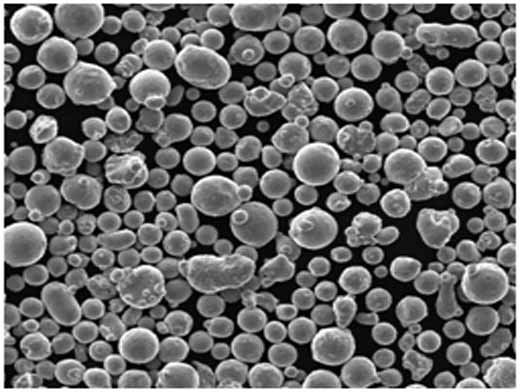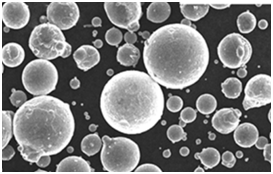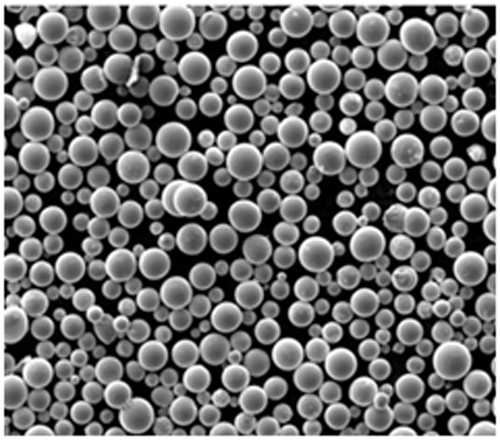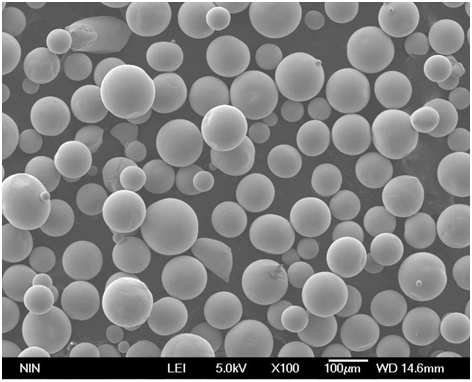لمحة عامة عن مساحيق المعادن الحرارية
عندما تفكر في المواد التي يمكنها تحمل الظروف القاسية، فإن المعادن المقاومة للحرارة هي الأبطال المجهولون في الجدول الدوري. تُستخدم هذه المعادن في عدد لا يحصى من التطبيقات ذات درجات الحرارة العالية، بدءًا من الفضاء وصولاً إلى التصنيع الصناعي. ولكن ما هي بالضبط مساحيق المعادن المقاومة للحرارة، ولماذا هي بالغة الأهمية في التقنيات المتقدمة؟
مساحيق المعادن المقاومة للحرارة هي جزيئات مقسمة بدقة من المعادن التي تتمتع بنقاط انصهار عالية بشكل استثنائي ومقاومة للغاية للتآكل والتآكل والتشوه. تشمل المعادن المقاومة للحرارة الأكثر شيوعًا التنغستن والموليبدينوم والتنتالوم والنيوبيوم والريينيوم. تُستخدم هذه المساحيق في تصنيع المكونات التي تحتاج إلى الأداء في ظل ظروف قاسية، كما هو الحال في محركات الطائرات والمفاعلات النووية وحتى استكشاف الفضاء.
لا يمكن المبالغة في أهمية مساحيق المعادن المقاومة للحرارة. تسمح لهم خصائصهم الفريدة بالاستخدام في البيئات التي تفشل فيها المواد الأخرى. سواء كنت مهندسًا أو عالمًا أو مجرد شخص مهتم بالمواد المتقدمة، فإن فهم خصائص هذه المساحيق وتطبيقاتها وأنواعها المختلفة أمر بالغ الأهمية.
يتعمق هذا المقال في عالم مساحيق المعادن المقاومة للحرارة، ويستكشف كل شيء بدءًا من تركيبها إلى تطبيقاتها، وحتى توفير مقارنة تفصيلية بين الأنواع المختلفة. دعنا نشرع في هذه الرحلة الفنية معًا.

أنواع وتركيب مساحيق المعادن المقاومة للحرارة
تأتي مساحيق المعادن المقاومة للحرارة في أنواع مختلفة، لكل منها تركيبه وخصائصه الفريدة. فيما يلي نظرة تفصيلية على بعض مساحيق المعادن المقاومة للحرارة الأكثر استخدامًا:
| المسحوق المعدني | التركيب | نقطة الانصهار | الكثافة | الخصائص الرئيسية |
|---|---|---|---|---|
| التنجستن (W) | تنجستن نقي | 3,422 درجة مئوية | 19.25 جم/سم³ | أعلى نقطة انصهار، قوة ممتازة في درجات الحرارة العالية، والتوصيل. |
| الموليبدينوم (Mo) | الموليبدينوم النقي | 2,623°C | 10.22 جم/سم³ | توصيل حراري جيد، مقاومة للتآكل، وتمدد حراري منخفض. |
| التنتالوم (Ta) | التنتالوم النقي | 3,017 درجة مئوية | 16.69 جم/سم³ | ليونة عالية، مقاومة ممتازة للتآكل، والتوافق الحيوي. |
| النيوبيوم (Nb) | النيوبيوم النقي | 2,468 درجة مئوية | 8.57 جم/سم³ | نقطة انصهار عالية، مقاومة ممتازة للتآكل، وخصائص فائقة التوصيل. |
| الرينيوم (Re) | رينيوم نقي | 3,185 درجة مئوية | 21.02 جم/سم³ | نقطة انصهار عالية للغاية، مقاومة جيدة للتآكل، وخصائص حفزية. |
| الكروم (Cr) | كروم نقي | 1,907 درجة مئوية | 7.19 جم/سم³ | صلابة عالية، مقاومة للتآكل، وخصائص عاكسة. |
| الهفنيوم (Hf) | هافنيوم نقي | 2,233 درجة مئوية | 13.31 جم/سم³ | مقاومة ممتازة للتآكل، نقطة انصهار عالية، وخصائص امتصاص النيوترونات. |
| الزركونيوم (Zr) | زركونيوم نقي | 1,855 درجة مئوية | 6.52 جم/سم³ | مقاومة عالية للتآكل، مقطع عرضي منخفض لالتقاط النيوترونات، وليونة جيدة. |
| إيريديوم (Ir) | إيريديوم نقي | 2,446 درجة مئوية | 22.56 جم/سم³ | كثافة عالية للغاية، مقاومة ممتازة للتآكل، ونقطة انصهار عالية. |
| أوزميوم (Os) | أوزميوم نقي | 3,033 درجة مئوية | 22.59 جم/سم³ | أعلى كثافة، صلابة عالية، ومقاومة ممتازة للتآكل. |
خصائص مساحيق المعادن الحرارية
إذن، ما الذي يجعل مساحيق المعادن المقاومة للحرارة مميزة جدًا؟ كل شيء في الخصائص. تتميز هذه المساحيق بخصائص ليست فريدة فحسب، بل ضرورية أيضًا للتطبيقات عالية الإجهاد. دعنا نقسم هذه الخصائص:
- نقاط الانصهار العالية: السمة الأكثر وضوحًا للمعادن المقاومة للحرارة هي نقاط انصهارها العالية بشكل لا يصدق، والتي غالبًا ما تتجاوز 2000 درجة مئوية. على سبيل المثال، يتمتع التنغستن بأعلى نقطة انصهار لأي معدن عند 3,422 درجة مئوية. هذه الخاصية تجعل هذه المعادن ضرورية في التطبيقات التي تكون فيها الحرارة الشديدة عاملاً، كما هو الحال في فوهات الصواريخ ومكونات الفرن.
- الكثافة العالية: تُعرف المعادن المقاومة للحرارة مثل التنغستن والرينيوم بكثافتها العالية. وهذا يجعلها مثالية للتطبيقات التي تتطلب مواد يمكنها امتصاص كميات كبيرة من الطاقة الحركية، كما هو الحال في الذخائر الخارقة للدروع.
- مقاومة التآكل: تظهر العديد من المعادن المقاومة للحرارة، وخاصة التنتالوم والنيوبيوم، مقاومة ممتازة للتآكل، حتى في البيئات الكيميائية القاسية. وهذا يجعلها مثالية للاستخدام في معدات المعالجة الكيميائية والزرعات الطبية.
- مقاومة التآكل: توفر الصلابة العالية للمعادن المقاومة للحرارة مثل الكروم والأوزميوم مقاومة ممتازة للتآكل، مما يجعلها مناسبة لأدوات القطع والطلاء المقاوم للتآكل والمكونات عالية المتانة.
- التوصيل الحراري والكهربائي: على الرغم من نقاط انصهارها العالية، فإن العديد من المعادن المقاومة للحرارة تمتلك أيضًا توصيلًا حراريًا وكهربائيًا جيدًا. هذا صحيح بشكل خاص بالنسبة للتنغستن والموليبدينوم، مما يجعلها مفيدة في التلامسات الكهربائية وعناصر التسخين.
- الليونة وقابلية التشغيل الآلي: في حين أن بعض المعادن المقاومة للحرارة معروفة بصلابتها، فإن البعض الآخر، مثل التنتالوم، يتمتع بليونة عالية، مما يعني أنه يمكن سحبه إلى أسلاك رفيعة دون أن تنكسر. هذه الليونة ضرورية في تطبيقات مثل الإلكترونيات وهندسة الفضاء.
تطبيقات مساحيق المعادن المقاومة للحرارة
نظرًا لخصائصها الفريدة، فليس من المستغرب أن تجد مساحيق المعادن المقاومة للحرارة طريقها إلى مجموعة واسعة من التطبيقات. إليك نظرة على الأماكن التي تُستخدم فيها هذه المواد بشكل شائع:
| طلب | مسحوق معدن مقاوم للحرارة المستخدم | الغرض |
|---|---|---|
| مكونات الفضاء الجوي | التنغستن، الموليبدينوم | مقاومة درجات الحرارة العالية في محركات الصواريخ والدروع الواقية من الحرارة وشفرات التوربينات. |
| المفاعلات النووية | الزركونيوم، الهافنيوم | امتصاص النيوترونات، مقاومة التآكل، والمكونات الهيكلية في المفاعلات. |
| الغرسات الطبية | التنتالوم، النيوبيوم | التوافق الحيوي ومقاومة التآكل في الغرسات والأطراف الصناعية. |
| الإلكترونيات | التنغستن، التنتالوم | الاستخدام في المكثفات والمقاومات والمكونات الإلكترونية الأخرى بسبب التوصيل والاستقرار. |
| أدوات القطع | التنغستن، الكروم | مقاومة التآكل والمتانة في أدوات القطع والحفر والتعدين. |
| معدات المعالجة الكيميائية | التنتالوم، الموليبدينوم | مقاومة التآكل في معدات التعامل مع الأحماض والمواد الكيميائية. |
| الدفاع والذخائر | التنغستن، الأوزميوم | مواد عالية الكثافة للذخائر الخارقة للدروع وأدوات الاختراق. |
| المحفزات في التفاعلات الكيميائية | الرينيوم، الإيريديوم | الخصائص الحفزية في التفاعلات الكيميائية، كما هو الحال في عمليات التكرير والتركيب. |
| الموصلات الفائقة | النيوبيوم | خصائص التوصيل الفائق في المغناطيسات وأجهزة التصوير بالرنين المغناطيسي ومسرعات الجسيمات. |
| المجوهرات والساعات | التنغستن، البلاتين | متانة عالية، مقاومة للتآكل، وجاذبية جمالية في السلع الفاخرة. |






المواصفات والأحجام والدرجات والمعايير
عند التعامل مع مساحيق المعادن المقاومة للحرارة، من المهم فهم المواصفات والأحجام والدرجات والمعايير التي تحكم استخدامها. تضمن هذه المعلمات استخدام المادة المناسبة للتطبيق المناسب، وأن الأداء متسق وموثوق به.
| معدن مقاوم للحرارة | حجم الجسيمات | الصف | قياسي | التطبيق النموذجي |
|---|---|---|---|---|
| التنغستن | 0.5 – 10 ميكرومتر | W1, W2, W3 | ASTM B777 | مكونات ذات درجة حرارة عالية، وصلات كهربائية. |
| الموليبدينوم | 1 – 15 ميكرومتر | Mo1, Mo2 | ASTM B386 | عناصر التسخين، طلاء الرش الحراري. |
| التنتالوم | 0.5 – 5 ميكرومتر | Ta1, Ta2 | ASTM B521 | الغرسات الطبية، معدات المعالجة الكيميائية. |
| النيوبيوم | 1 – 20 ميكرومتر | Nb1, Nb2 | ASTM B392 | الموصلات الفائقة، المفاعلات النووية. |
| الرينيوم | 0.1 – 5 ميكرومتر | Re1, Re2 | ASTM F1760 | المحفزات، المزدوجات الحرارية ذات درجة الحرارة العالية. |
| الكروم | 1 – 50 ميكرومتر | Cr1, Cr2 | ASTM B835 | طلاء مقاوم للتآكل، إنتاج السبائك. |
| هافنيوم | 0.2 – 10 ميكرومتر | Hf1, Hf2 | ASTM B776 | المفاعلات النووية، مكونات الفضاء. |
| الزركونيوم | 1 – 25 ميكرومتر | Zr1, Zr2 | ASTM B551 | المعالجة الكيميائية، المفاعلات النووية. |
| إيريديوم | 0.1 – 10 ميكرومتر | Ir1, Ir2 | ASTM B785 | وصلات كهربائية، شمعات الإشعال. |
| أوزميوم | 0.5 – 5 ميكرومتر | Os1, Os2 | مواصفات مخصصة | طلاء مقاوم للتآكل، إنتاج السبائك. |
تفاصيل الموردين والأسعار
العثور على المورد المناسب لـ مساحيق معدنية حرارية أمر بالغ الأهمية، حيث يمكن لجودة المسحوق واتساقه أن يؤثرا بشكل كبير على تطبيقك. يمكن أن تختلف الأسعار بناءً على عوامل مثل النقاء وحجم الجسيمات وديناميكيات سلسلة التوريد.
| المورد | المعادن المقاومة للحرارة المعروضة | متوسط السعر (لكل كجم) | المنطقة | التخصص |
|---|---|---|---|---|
| إتش سي ستارك | التنغستن، الموليبدينوم، التنتالوم، النيوبيوم | $500 – $2,000 | عالمي | مساحيق عالية النقاء، أحجام جسيمات مخصصة |
| التنجستن والمساحيق العالمية | التنغستن، الرينيوم، التنتالوم | $600 – $2,500 | أمريكا الشمالية، أوروبا | مساحيق عالية الأداء |
| ATI | تنغستن، هافنيوم، زركونيوم | $450 – $1,800 | الولايات المتحدة الأمريكية | إمدادات موثوقة للصناعات الحيوية، مجموعة واسعة من المعادن المقاومة للحرارة. |
| بلانسي | موليبدنوم، تنغستن، نيوبيوم | $400 – $1,500 | أوروبا، آسيا | متخصصة في التطبيقات ذات درجة الحرارة العالية، وإنتاج السبائك المخصصة. |
| شركة سبائك الرينيوم، ذ.م.م. | رينيوم، سبائك موليبدنوم-رينيوم | $2,000 – $10,000 | الولايات المتحدة الأمريكية | أسواق متخصصة، سبائك مخصصة، مواد عالية الأداء. |
| مجموعة زوزهو كربيد الأسمنتية | تنغستن، كروم، تانتالوم | $300 – $1,200 | الصين | إنتاج واسع النطاق، تسعير تنافسي، جودة موثوقة. |
| شركة تريباتشر إندستري إيه جي | تنغستن، تانتالوم، نيوبيوم | $500 – $2,000 | أوروبا، أمريكا الشمالية | مواد عالية النقاء، حلول مخصصة، دعم قوي للبحث والتطوير. |
| CBMM | النيوبيوم | $800 – $3,000 | عالمي | المنتج الرائد للنيوبيوم، تركيز قوي على الجودة والابتكار. |
| شركة تشيبتسكي المساهمة | الزركونيوم، الهافنيوم | $600 – $2,200 | روسيا، أوروبا | متخصصة في المواد النووية، مساحيق عالية النقاء. |
| العناصر الأمريكية | جميع المعادن المقاومة للحرارة | $400 – $10,000 | عالمي | مجموعة واسعة من المنتجات، كميات صغيرة إلى كبيرة، التركيز على الابتكار. |
مزايا وقيود مساحيق المعادن المقاومة للحرارة
في حين أن مساحيق المعادن المقاومة للحرارة توفر فوائد لا تصدق، إلا أنها تأتي أيضًا مع بعض القيود. إليك مقارنة بين إيجابياتها وسلبياتها:
| الميزة | التقييد |
|---|---|
| مقاومة درجات الحرارة العالية: يمكن للمعادن المقاومة للحرارة تحمل درجات الحرارة القصوى، مما يجعلها مثالية للتطبيقات عالية الإجهاد مثل الفضاء والمفاعلات النووية. | التكلفة: غالبًا ما تكون هذه المعادن باهظة الثمن بسبب ندرتها وتعقيد استخلاصها ومعالجتها. |
| مقاومة التآكل: المعادن مثل التانتالوم والنيوبيوم شديدة المقاومة للتآكل، مما يجعلها مناسبة للمعالجة الكيميائية والتطبيقات الطبية. | صعوبة التشغيل: من الصعب تشغيل بعض المعادن المقاومة للحرارة بسبب صلابتها وهشاشتها. |
| الكثافة العالية: كثافة المعادن العالية مثل التنغستن والأوزميوم تجعلها مناسبة للتطبيقات التي تتطلب الوزن وامتصاص الطاقة الحركية، كما هو الحال في الدفاع والفضاء. | التوفر: بعض المعادن المقاومة للحرارة، مثل الرينيوم والإيريديوم، نادرة ولها توافر محدود، مما قد يؤدي إلى تحديات في سلسلة التوريد. |
| مقاومة التآكل: توفر المعادن المقاومة للحرارة مثل الكروم مقاومة ممتازة للتآكل، وهو أمر بالغ الأهمية لأدوات القطع والطلاءات المقاومة للتآكل. | الأكسدة: بعض المعادن المقاومة للحرارة، وخاصة الموليبدنوم والتنغستن، عرضة للأكسدة في درجات الحرارة المرتفعة ما لم يتم حمايتها بالطلاءات أو في بيئات خاملة. |
| الليونة: المعادن مثل التانتالوم شديدة الليونة، مما يسمح بتشكيلها في أشكال معقدة دون تشقق، وهو أمر ضروري للمكونات الإلكترونية والأجهزة الطبية. | السمية: يمكن أن تكون بعض المعادن المقاومة للحرارة ومركباتها سامة، مما يتطلب التعامل والتخلص منها بعناية. |

أسئلة وأجوبة
| سؤال | الإجابة |
|---|---|
| ما هي مساحيق المعادن المقاومة للحرارة؟ | مساحيق المعادن المقاومة للحرارة عبارة عن جزيئات دقيقة من المعادن ذات نقاط انصهار عالية، وتستخدم في التطبيقات التي تتطلب مقاومة شديدة للحرارة والتآكل. |
| لماذا تعتبر المعادن المقاومة للحرارة باهظة الثمن؟ | غالبًا ما تكون هذه المعادن نادرة ويصعب استخلاصها ومعالجتها، مما يؤدي إلى ارتفاع تكلفتها. |
| ما هو أصعب معدن مقاوم للحرارة؟ | يعتبر التنغستن أصعب معدن مقاوم للحرارة، بصلابة موس تبلغ 7.5. |
| هل يمكن تشغيل المعادن المقاومة للحرارة؟ | نعم، ولكن من الصعب تشغيل بعضها بسبب صلابتها وهشاشتها، مما يتطلب أدوات وتقنيات متخصصة. |
| هل المعادن المقاومة للحرارة آمنة للاستخدام؟ | بشكل عام، نعم، ولكن بعضها يمكن أن يكون سامًا أو خطيرًا في أشكال معينة، مما يتطلب التعامل السليم واحتياطات السلامة. |
| ما هو المعدن المقاوم للحرارة الذي يتمتع بأعلى نقطة انصهار؟ | يتمتع التنغستن بأعلى نقطة انصهار لأي معدن، عند 3,422 درجة مئوية. |
| كيف يتم تصنيع مساحيق المعادن المقاومة للحرارة؟ | يتم إنتاجها عادةً من خلال عمليات مثل الاختزال الهيدروجيني أو الاختزال الكربوحراري أو التحليل الكهربائي. |
| ما هي الصناعات التي تستخدم مساحيق المعادن المقاومة للحرارة؟ | تستخدم صناعات مثل الفضاء والدفاع والإلكترونيات والطبية والنووية والمعالجة الكيميائية هذه المساحيق بشكل كبير. |
| هل يمكن للمعادن المقاومة للحرارة مقاومة التآكل؟ | نعم، المعادن مثل التانتالوم والنيوبيوم شديدة المقاومة للتآكل، حتى في البيئات الكيميائية القاسية. |
| لماذا تعتبر المعادن المقاومة للحرارة مهمة في المفاعلات النووية؟ | نقاط انصهارها العالية ومقاومتها لتلف الإشعاع تجعلها ضرورية للمكونات في المفاعلات النووية. |

